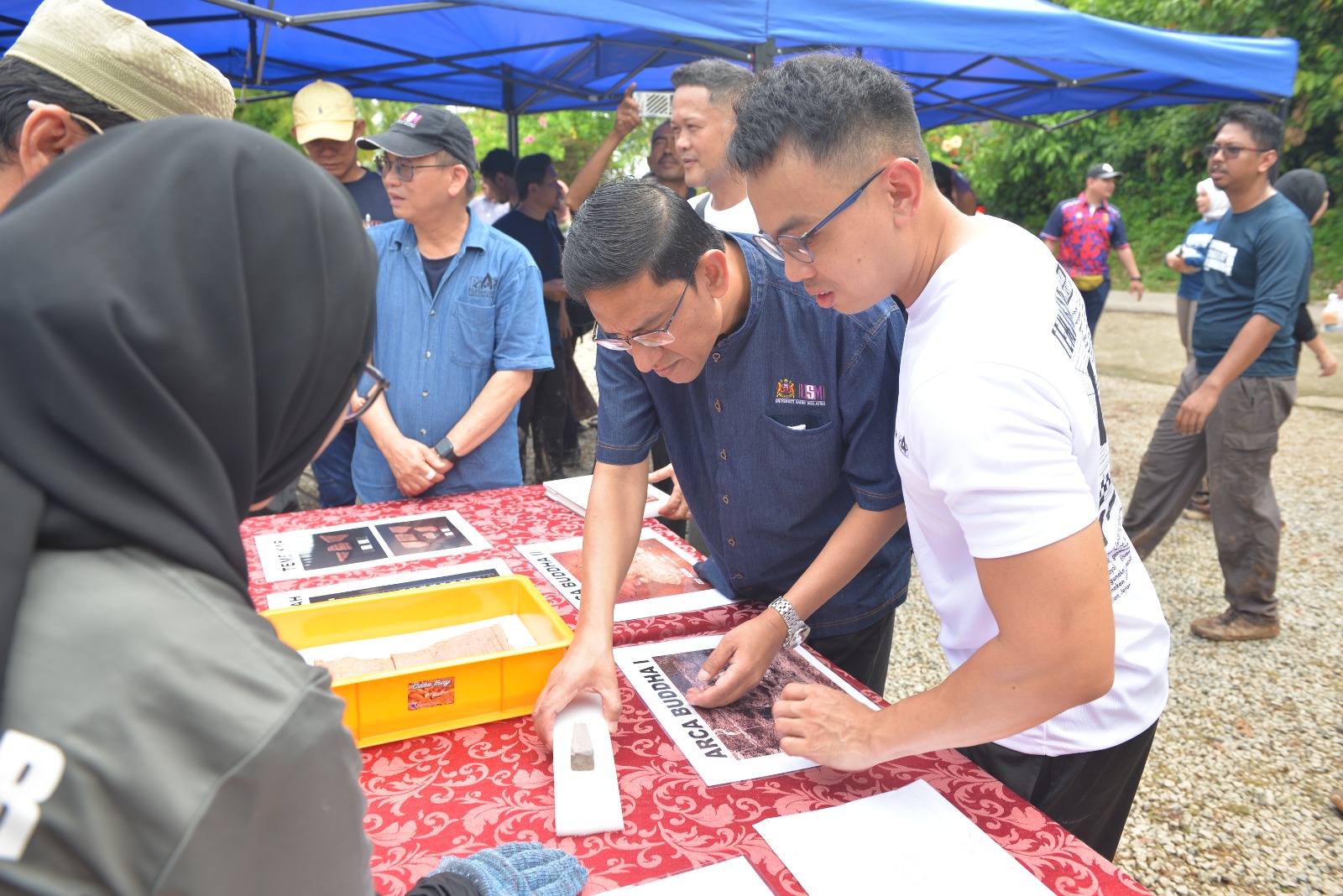HISTORICAL DISCOVERY: USM CGAR TEAM UNEARTHS THE LARGEST ANCIENT TEMPLE AT BUKIT CHORAS - HIGHLY ARTISTIC BUILDING STRUCTURE AND ARTEFACTS
YAN, KEDAH, 29 September 2023 – Researchers from the USM Centre for Global Archaeological Research (CGAR) had recently made a very important discovery that confirmed the existence and size of an ancient building structure and artefacts with artistic elements, believed to be dating back some 1,200 years, at the Bukit Choras Archaeological Site here.

The excavation work, which was carried out in collaboration with the National Heritage Department (JWN) and the Ministry of Tourism, Arts and Culture (MOTAC), revealed five main discoveries, namely the temple structure, two sculptures, a Kalam Semah, an inscription stone and earthenware fragments.
USM CGAR senior lecturer, Dr. Nasha Rodziadi Khaw, who led the research and excavation work funded through the FRGS grant from the Ministry of Higher Education, said the purpose of the excavation at the site was to confirm the existence and size of the structure that had been detected through a geophysical study that was conducted in 2017.
“Excavation and research work was carried out at the summit of Bukit Choras between 28 August and 12 September 2023, and our initial findings had led us to believe that the temple site could date back to around the eighth or ninth century AD, which is the same as most of the temple sites in the Bujang Valley and the development period of the Srivijaya Empire.

“The uniqueness of this temple at this archaeological site is first and foremost in how it has been preserved. We can see that the walls in the north, west, and south areas are well preserved.
“Secondly, we discovered two human-sized structures made of stucco, and the discovery of stucco has not been reported in the Bujang Valley but only in Sumatra and Java,” he said at a press conference here today.
Nasha said based on preliminary research, there is a similarity between the temple architecture in Bukit Choras and that of the temples in West Java and Sumatra, raising questions about the cultural relationship between Kedah Tua and other ancient civilization sites in South-East Asia.
“The temple is estimated to measure nine square metres, but the actual size can only be confirmed after the excavation work is done, which is currently 40% complete.”
He said the Bukit Choras Archaeological Site is considered special due to its isolated position north of Gunung Jerai, whereas the other archaeological sites in Bujang Valley are mostly situated south of Gunung Jerai around Sungai Merbok and Sungai Muda.
“My team still needs time to do more on-site research, perhaps for several years, before any conclusion can be made about the ancient site.
“I hope at the end of the day, we can provide more information and data that can add value to the rich history of Kedah Tua.
“This temple is also the biggest ever found in Bujang Valley and has an interesting artistic architecture,” he added.
The Bukit Choras Archaeological Site, which was gazetted as a heritage site under the National Heritage Act 2005 (Act 645) on 28 December 2016, has now proven its historical significance beyond doubt.
This collaborative pilot project, initiated following the signing of a Memorandum of Understanding (MoU) between JWN and eleven local public universities back in March 2023, has brought to light previously hidden treasures.
Meanwhile, USM Vice-Chancellor, Professor Dato’ Ir. Dr. Abdul Rahman Mohamed said the university’s research team has been excavating the archaeological sites in Lembah Bujang for the past 10 years with funding from the Ministry of Higher Education.
“We have been working and will continue to work closely with JWN and other related parties to further develop and expand our archaeo-tourism products.
“There is still a lot of excavation work that we hope to carry out in the Lembah Bujang area. Furthermore, we believe this important discovery will shed some light on the facts and allow us to review historical events written by western historians," said Abdul Rahman.
Also present at the site was USM CGAR Director, Professor Dr. Stephen Chia Ming Soon, who added, “we are all very excited with the discovery, and the first phase of excavation work conducted for two weeks had revealed that the temple still maintained its full building structure with the entire west wall of the temple and half of the north and south walls intact.
"The statues and artifacts found at the site will be taken to the USM Archaeology Gallery for conservation and further research.
“The second phase of excavation work on the remaining temple structure is expected to resume in January next year,” he said.
Text: Tan Ewe Hoe/Photo: Shahnizam Ab Rahim
- Created on .
- Hits: 1792
